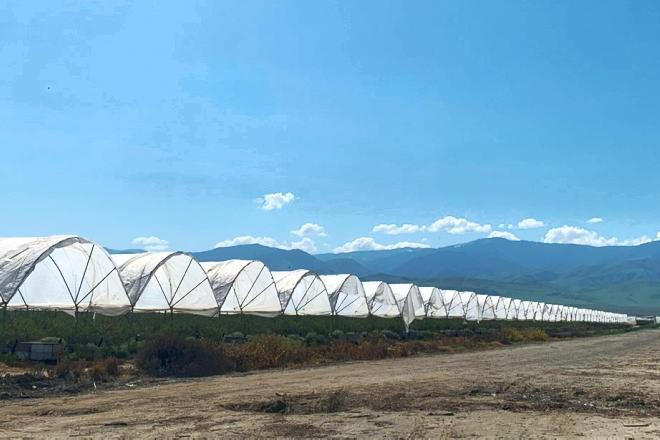Horticulture is the fourth largest agricultural sector in farmgate value, worth €521m in 2023. Within this, controlled environment agriculture (CEA), encompassing everything from shade houses to green house and vertical farms, contributes produce for direct human consumption, plants for growing in field production and for amenity usage.
My research aimed to examine the commercial viability of new sustainable horticultural practices in controlled environment crop production in the face of policy and regulatory changes, fluctuating consumer demands and market trends, labour availability challenges, climate change and rising input costs. Many are global issues, so we have much to learn from our international counterparts.
During my travels I visited 11 countries, including New Zealand, California, Japan, Belgium and the Netherlands.
In each, discussions with growers, breeders, government representatives, research agencies and industry suppliers formed a picture of what horticultural production, its limitations and opportunities looked like in their context.
I wanted to learn about the resilience of grower communities, production challenges and how they overcome them.
Output
Controlled environments such as glasshouses and tunnels are high-intensity production systems, with the capacity to produce large volumes of both edible and non-edible crops year-round, in comparatively small areas. The factors impacting output from these systems include:
The level of space optimisation, maximising crop turnover and minimising the down time on unplanted or unutilised growing space.Strategic crop selection to maximise the return per square metre of a facility, considering fluctuating market demands, practical crop requirements (temperatures and light levels) and available resources (eg irrigation, labour).Alternative approaches to maintain quality and profit margins in an increasingly challenging regulatory environment. For example, growing crops with less chemical intervention and a greater reliance on biological solutions and environment manipulation. Increasingly important role of technology for improved production efficiency and less labour dependant systems, effectively reducing long term production costs and improving overall efficiency of systems.The pressures and opportunities of a changing climate on environmental conditions with changing heat and light level intensity, alterations to rain fall volumes and patterns. When it comes to recommending sustainable approaches, much depends on the type of system being examined – extensive or intensive, growing ‘cold, slow and low or hot, fast and high’.
In controlled environments, growing crops with shorter programme times to optimise space and time requires higher inputs.
This increases crop value and volume, but also production costs. Growing ‘slow and cold’, on the other hand, entails lower inputs but reduced turnover.
These are two different approaches dependent on infrastructure, available resources and the crop.
These are equally applicable to finished or young plant producers or systems combining the two.

Dutch glasshouse production showing intensive young plant production.
As producers, to improve the efficiency of our output, we must do several things:
Evaluate our system: this is key for identifying where there is room for growth and development, or when ruthlessness around systems or crops that no longer serve their purpose is required. Be flexible for resilience: this is critical with extreme weather patterns pushing both ends of the environmental spectrum. These include unpredictable rain falls, increased energy usage to mitigate temperature drops and crop losses due to heat stress. With more challenging production environments, climate mitigation measures must be considered to optimise performance. Re-evaluating established growing practices, and embracing innovative disease and pest control practices will be even more pertinent. A changing regulatory environment, consumer demands and environmental and health concerns all drive the need for change. Precision use of inputs: the precision use of costly inputs reduces waste and maximises return per square metre from every kilogramme, litre or kilowatt of inputs. Calculating what works best under these conditions can result in small changes having a cumulative impact on outcomes. What else can we do to improve the sustainability of the horticulture industry?
Climate mitigation: in terms of climate mitigation, we need to look more seriously towards national infrastructure investment and allocate appropriate resources to future-proofing production systems which are so reliant on limiting factors like water. The implementation gap: we have had numerous reports and strategies on the future of horticulture. However, there is a gap between recommendations and uptake. More work needs to be done for this information to be disseminated among producers and to engage them in setting future targets and industry key progress indicators (KPIs). Bord Bia, Teagasc and the Department of Agriculture all do vital work to support and promote the industry. But they need to do more to implement those findings and recommendations through discussion groups, fiscal or educational supports or a combined approach. National and international collaboration: we operate within a highly competitive domestic market which disincentivises information sharing. Yet, there is room for non-technically specific collaboration on bigger picture issues. An increase in communication between industry stakeholders and with our counterparts abroad, could help build resilience within our production environments and advance the horticulture industry, improving our collective ability to deal with future challenges. From New Zealand to the Netherlands, collaborative mindsets were crucial in building community resilience and improving industry outcomes. The value of a ‘nugget’ of information: it’s not always about huge changes or costly investments, sometimes it’s the nugget of information that you take away from an encounter that can make a big practical difference or inspire change. Learn from our neighbours, each other, over the hedge and over the sea. *Liagh Whelehan is a 2023 Nuffield Ireland Scholar and a horticulturist working for a Wexford-based grower. Liagh used her scholarship to identify solutions to the sustainable production of plants in controlled environments.

